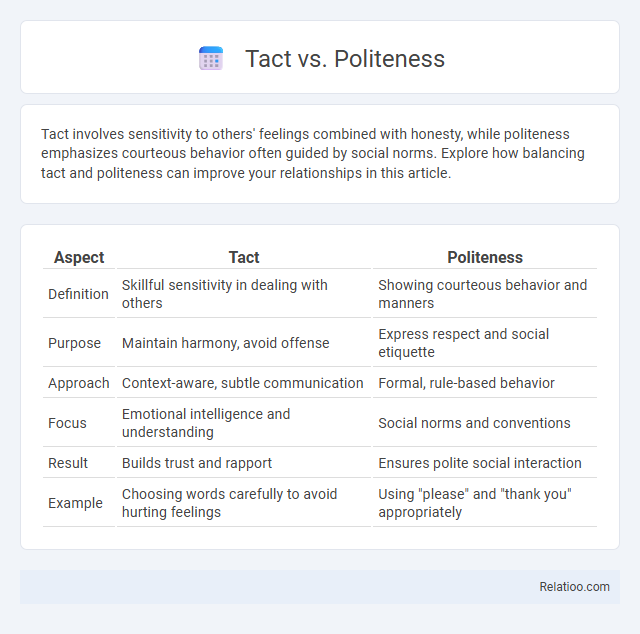Tact involves sensitivity to others' feelings combined with honesty, while politeness emphasizes courteous behavior often guided by social norms. Explore how balancing tact and politeness can improve your relationships in this article.
Table of Comparison
| Aspect | Tact | Politeness |
|---|---|---|
| Definition | Skillful sensitivity in dealing with others | Showing courteous behavior and manners |
| Purpose | Maintain harmony, avoid offense | Express respect and social etiquette |
| Approach | Context-aware, subtle communication | Formal, rule-based behavior |
| Focus | Emotional intelligence and understanding | Social norms and conventions |
| Result | Builds trust and rapport | Ensures polite social interaction |
| Example | Choosing words carefully to avoid hurting feelings | Using "please" and "thank you" appropriately |
Understanding the Concepts: Tact and Politeness
Tact involves the skillful handling of sensitive situations to avoid offense, often requiring emotional intelligence and situational awareness. Politeness refers to the adherence to social norms and courteous behavior that maintains respect and harmony in interactions. While both concepts aim to foster positive communication, tact is more about strategic sensitivity in responses, whereas politeness centers on following established etiquette rules.
The Key Differences Between Tact and Politeness
Tact involves the skillful handling of sensitive situations to avoid offending others, while politeness refers to the general use of socially acceptable manners and behaviors. The key difference lies in tact's focus on empathy and thoughtful communication tailored to specific contexts, whereas politeness emphasizes adherence to social norms regardless of context. Your ability to distinguish between these ensures effective interpersonal interactions and fosters respect.
The Importance of Tact in Communication
Tact plays a crucial role in communication by allowing you to convey messages thoughtfully and respectfully, minimizing misunderstandings and conflicts. Unlike politeness, which follows social rules or etiquette, tact involves sensitivity to the feelings and perspectives of others while maintaining honesty. Mastering tact enhances your interpersonal skills, fostering trust and effective dialogue in both personal and professional settings.
The Role of Politeness in Social Interactions
Politeness plays a crucial role in social interactions by facilitating mutual respect and minimizing potential conflicts, thereby maintaining harmonious relationships. Your ability to employ politeness helps navigate social norms and expectations, making conversations more effective and pleasant. Unlike tact, which involves sensitivity in delicate situations, politeness focuses broadly on courteous behavior that fosters positive communication.
Cultural Variations in Tact and Politeness
Cultural variations in tact and politeness significantly influence interpersonal communication styles, with some cultures emphasizing indirectness and subtlety to maintain harmony, while others value directness and clarity. In East Asian cultures, high-context communication prioritizes face-saving and non-verbal cues, contrasting with Western low-context cultures where explicit verbal politeness and straightforward feedback are common. Understanding these cultural nuances is crucial for effective cross-cultural interactions, reducing misunderstandings, and fostering respectful dialogue that aligns with diverse social norms.
When to Use Tact Over Politeness
Tact is essential when addressing sensitive topics or providing constructive criticism, as it balances honesty with empathy to avoid hurt feelings. Politeness generally involves following social norms and manners but may lack the nuanced sensitivity required in delicate situations. Use tact over politeness when the goal is to maintain trust and understanding while delivering potentially uncomfortable truths.
Potential Pitfalls of Excessive Politeness
Excessive politeness can obscure clear communication, causing misunderstandings and reducing the effectiveness of your message. Tact involves balancing kindness with honesty to address sensitive issues without offending, whereas politeness may prioritize formality and social etiquette over clarity. Understanding these distinctions helps you navigate social interactions by conveying respect while maintaining transparent and assertive dialogue.
Strategies for Balancing Tact and Politeness
Balancing tact and politeness requires employing strategies such as active listening, choosing words carefully to convey respect without ambiguity, and considering the cultural context to avoid misunderstandings. Utilizing empathetic communication helps maintain honesty while preserving the recipient's dignity. Effective nonverbal cues, such as appropriate eye contact and body language, reinforce polite intentions and tactful messaging in sensitive conversations.
Real-Life Scenarios: Tact Versus Politeness
Tact involves carefully choosing words and actions to avoid offending others, often requiring emotional intelligence and situational awareness, while politeness refers to following social norms and etiquette to show respect and consideration. In real-life scenarios, tact is crucial when delivering critical feedback or addressing sensitive topics, as it helps maintain relationships without causing resentment. Politeness ensures smooth social interactions and mutual respect but may lack the nuanced understanding necessary for complex interpersonal dynamics where tact is key.
Enhancing Communication Skills: Mastering Tact and Politeness
Mastering tact and politeness enhances communication skills by fostering respectful and clear interactions, reducing misunderstandings and conflicts. Tact involves sensitivity to others' feelings and delivering messages thoughtfully, while politeness adheres to social norms and cultural etiquette, ensuring positive reception. Effective communicators blend tactfulness with politeness to build trust, maintain professionalism, and facilitate productive conversations across diverse settings.

Infographic: Tact vs Politeness
 relatioo.com
relatioo.com